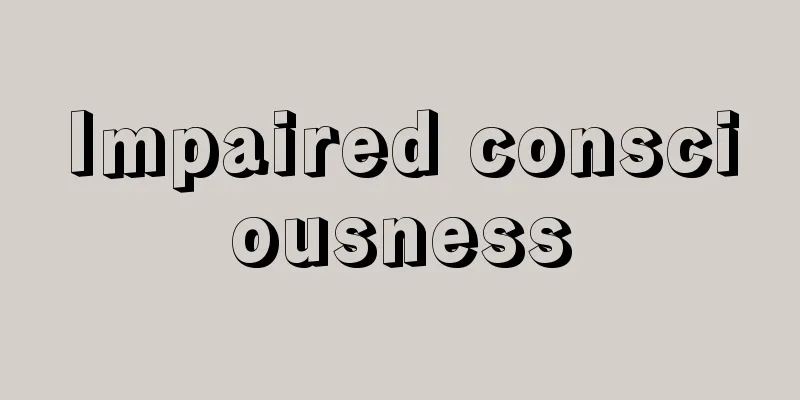Impaired consciousness

|
Concept The mechanism of neural activity that is the source of consciousness is not precisely understood. Details of the neural mechanisms of the hypothalamus that control the circadian rhythm and the ascending arousal system that is controlled by it are gradually becoming clear, but a complete picture of the reticular activating system has not yet been presented (Figure 15-3-1A). In addition, since minimal general anesthesia that induces consciousness hardly suppresses the excitability of cerebral cortical neurons or the activity of ascending arousal system neurons, it is recognized that another element that has not yet been precisely elucidated is essential for the brain activity that produces consciousness. In clinical practice that is based on empirical theory, simplified models are often more useful than detailed neuroscientific descriptions. Clinical treatment of disorders of consciousness is no exception, and a unified model that connects the activated cerebral cortex and the reticular activating system that maintains that activation is easy to understand and has high clinical suitability. In this model, the cerebral cortex is understood as a collection of various "functional units," and the reticular activating system is understood as an "activating device" that exists near the reticular system from the midbrain to the rostral side of the midbrain, and no specific route is defined as the "wiring" that connects the two (Figure 15-3-1B). A state in which arousal is completely lost is called coma, a state in which arousal is not achieved but there is a reaction such as avoidance behavior to unpleasant stimuli is observed is called stupor, and a state in which the patient can be aroused by stimulation and the cerebral cortical function can be confirmed, but the patient cannot maintain the state of awakening on his/her own is called drowsiness or somnolence. A term used to dispel ambiguity in the determination of brain death is deep coma, a term that emphasizes the complete unresponsiveness to external stimuli. A state in which arousal is maintained and the cerebral cortical function can be confirmed, but normal cognitive ability is lacking, is called a confusional state. This is a non-specific widespread dysfunction of the cerebral cortex, and is observed in cases of higher-level functional disorders such as psychiatric disorders and dementia, but in cases where it progresses rapidly, it is often the initial symptom of impaired consciousness due to metabolic disorders, drugs, infections, etc. An acute confusional state exhibiting strong positive findings such as agitation, delusions, hallucinations, and illusions is called delirium. When the reticular activating system is functioning normally and there is a sleep-awake cycle, but there is chronic cerebral cortical dysfunction and a lack of awareness of the self and its relationship to the outside world continues for more than a few weeks, this is called a vegetative state. It is most often a transitional type from a coma, but it can also be seen in cases of terminal chronic degenerative diseases and severe developmental disorders. According to the pathophysiological reticular activating system model (Figure 15-3-1B), coma is a disorder of cerebral cortical activation, and occurs when the function of the cerebral cortex, the seat of consciousness, is widely affected, or when the function of the reticular activating system is impaired. Diseases that are likely to cause coma due to dysfunction of the entire cerebral cortex are diseases that have the characteristic of spreading lesions rapidly to the entire surface of the cerebrum. Representative examples are bacterial meningitis and subarachnoid hemorrhage, whose lesions spread through the subarachnoid space, metabolic diseases and drug poisoning, whose effects spread to the entire cerebrum through the bloodstream, and convulsive diseases, whose effects spread electrically to the entire neuronal network, causing cerebral cortical dysfunction. Diseases that are likely to cause coma due to dysfunction of the reticular activating system are organic diseases that affect the brainstem, especially the area from the midbrain to the diencephalon. Representative examples include brainstem infarction due to occlusion of the perforating branch branching off from near the upper end of the basilar artery, basilar artery occlusion, and brainstem compression due to hypertensive pontine hemorrhage and cerebellar hemorrhage. Coma does not occur due to organic focal damage to the cerebral cortex alone. Therefore, in cases where an organic disease of the cerebral cortex has led to coma, tentorial herniation due to mass effect must be suspected (Figure 15-3-2). Representative examples include rapidly growing brain tumors, cerebral edema due to widespread infarction or trauma, and large hematomas. Neurological findings The neurological findings that can be obtained in comatose patients are extremely limited, and examination of the reflex pathways of brainstem function is the main focus. 1) Response to unpleasant stimuli: Painful stimulation with a pinprick and strong pressure applied with a finger to the orbital notch are still recognized as noxious stimuli. However, as a preventative measure against infection, disposable pins (insect pins, safety pins, toothpicks, etc.) should be used. If the patient opens their eyes or exhibits avoidance behavior, they are considered to be in a stupor, with a milder disturbance to arousal than coma. Reflex posturing seen in a coma can be classified as decorticate posturing or decerebrate posturing (Figure 15-3-3). 2) Pupils and light reflex: The iris is dually innervated by the sympathetic and parasympathetic nerves (Figure 15-3-4). Sympathetic stimulation causes mydriasis, while parasympathetic stimulation causes miosis. The final size of the pupil is determined by the balance between the two. The central sympathetic efferent pathway starts from the posterior hypothalamus, descends through the brainstem tegmentum to the thoracic spinal cord, and reaches the preganglionic nerves of the first and second lateral horns of the thoracic spinal cord. Disorders in this efferent pathway cause miosis (the so-called central Horner syndrome). Thalamic hemorrhage causes unilateral or bilateral miosis, while pontine hemorrhage causes bilateral, extremely severe miosis (the so-called pinpoint pupil). In both cases, the pupillary light reflex is generally maintained. The parasympathetic preganglionic nucleus (Edinger-Westphal nucleus) is located inside the oculomotor nucleus, receives signals from the optic nerve bilaterally, and forms the pupillary light reflex pathway (Figure 15-3-4). Therefore, parasympathetic nervous system disorders simultaneously result in dilated pupils and loss of the light reflex. Oval, off-centered pupils are called corectopia and are considered a sign of incomplete dysfunction of the parasympathetic nervous system, and are seen in disorders of the rostral midbrain and oculomotor nerve disorders (especially in the early stages of the disease). 3) Eye movements and vestibulo-ocular reflex: The horizontal gaze center is located in the pons, in the paramedian pontine reticular formation (PPRF). The centrifugal fibers from the PPRF to the oculomotor nuclei cross immediately after leaving the PPRF and ascend in the contralateral medial longitudinal fasciculus (MLF) (Figure 15-3-5). Therefore, in cases of coma, if horizontal conjugate eye movements can be observed bilaterally, brainstem disorders from the midbrain to the pons can be excluded. If spontaneous eye movements are observed in comatose patients, they are often horizontal conjugate eye movements that slowly swing back and forth (so-called roving eye movements). Since this movement cannot be imitated intentionally, it provides a definitive diagnosis of coma and also ensures that there is no brainstem disorder. If spontaneous eye movements are not observed, horizontal conjugate eye movements are examined by eliciting the vestibulo-ocular reflex (VOR). The doll's eye phenomenon is a diagnostic method that induces endolymph movement directly by rotating the head horizontally, while the caloric test is a diagnostic method that induces endolymph movement due to temperature differences by injecting cold or warm water into the external ear, thereby inducing a horizontal vestibulo-ocular reflex. The former is in the opposite direction to the rotational movement, and the latter varies depending on the patient's position and whether the water is cold or warm. In a typical supine position, when cold water is injected, eye movement occurs in the direction of gazing at the injected side. Strictly speaking, the vestibulo-ocular reflex pathway is not the same as the voluntary horizontal conjugate eye movement pathway, but it is easy to understand if you think of it as PPRF activity being stimulated by a command from the contralateral frontal eye field when voluntary movement stimulates PPRF activity, and then a command from the contralateral vestibular nerve (Figure 15-3-5). Fixed gaze may be observed in comatose patients. Horizontal deviation is called conjugate deviation, and vertical deviation is called sustained gaze. Conjugate deviation occurs when the balance between the left and right PPRF activities is lost. If the PPRF itself on one side is destroyed, gaze will be toward the other side, whereas if the PPRF on the other side is diaschisis due to damage to the frontal eye field, gaze will be toward the diseased side. Sustained gaze is a phenomenon seen when widespread damage to the cerebral cortex occurs due to cardiac arrest, etc. Sustained upgaze is the most common, and if it transitions to downbeat nystagmus, it can be considered a finding suggesting recovery of cortical function. Sustained downward gaze is often seen during the transition to a vegetative state. Although the eye movements are spontaneous, both eyes may deviate downward as if dropping, then slowly return to the midline, and this downward deviation may be repeated. This movement is called ocular bobbing, and in many cases the eyes are not in sync (dysconjugation). This is a poor prognostic finding that suggests widespread organic damage to the brain stem. Differential diagnosisComa is not merely a symptom, but a clinical diagnosis in itself. In particular, it is essential to distinguish locked-in syndrome, which is easily misdiagnosed as coma because of the lack of responsiveness despite the absence of impaired consciousness, and a diagnosis of coma should not be made without first distinguishing it. 1) Locked-in syndrome: Bilateral damage to the pontine base results in the complete blockage of the efferent pathways of the voluntary motor system, including language. As the nervous tissue above the midbrain functions normally, consciousness and cerebral cortical activity are maintained, and as the nervous tissue below the medulla oblongata functions normally, spontaneous breathing is also maintained. If damage extends to the area around the medial lemniscus, some somatosensory sensation is impaired, and horizontal eye movement is also impaired due to damage to the PPRF, the horizontal gaze center, and bilateral facial nerve paralysis is observed, but the afferent pathways of hearing and pain are maintained because they are located further dorsally. As a result, the patient is conscious and has normal vision, hearing, and pain, but the voluntary motor system that allows for the expression of will is almost inactive, and the patient presents with the clinical condition of being mistaken as if in a coma. This is the locked-in syndrome. The vertical gaze center is the rostral interstitial nucleus of medial longitudinal fasciculus (riMLF) in the midbrain, and because it is located in the midbrain, voluntary vertical eye movements remain in many cases. However, because neuronal activity on the rostral side of the PPRF is also necessary for voluntary vertical eye movements, even vertical eye movements are affected, and in many cases the only voluntary motor function remaining for expressing one's will is the opening and closing of the eyelids. 2) Psychogenic unresponsiveness: Psychogenic unresponsiveness belongs to a group of diseases that are basically diagnosed by exclusion, but in many cases it can be differentiated clinically. Slow horizontal conjugate roving eye movements, which frequently occur in metabolic encephalopathy and other conditions, are an inimitable neurological finding, and when observed, they are a definitive diagnosis of coma. During the cold water caloric test, there is often an effort to deliberately prevent eye movement, and the patient may wake up due to the discomfort of the cold water stimulation. When nystagmus including corrective saccades is observed, rather than conjugate deviation towards the side of the stimulation, this is often a confirmation of cerebral cortical activity, leading to a definitive diagnosis of psychogenic unresponsiveness. [Nakada Chikara] A: Ascending arousal system, B: Reticular activating system "> Figure 15-3-1 Reflex Postures in a Coma Figure 15-3-3 Innervation of the iris Figure 15-3-4 Voluntary horizontal conjugate eye movement pathway and vestibulo-ocular reflex "> Figure 15-3-5 Disturbance of consciousness (symptomatology)A pathological state in which arousal is completely lost is called coma, a state in which a person shows reactions such as avoidance behavior to unpleasant stimuli is called stupor, a state in which a person can be aroused by stimuli and cerebral cortical function can be confirmed but is unable to maintain a state of wakefulness on their own is called drowsiness or somnolence. A state in which a person maintains wakefulness and cerebral cortical function can be confirmed but normal cognitive ability is lacking is called a confusional state, and a chronic state in which the cerebral cortex is unable to process information despite the reticular activating system working normally is called a vegetative state. Pathophysiology : Impaired consciousness occurs when the function of the cerebral cortex, the seat of consciousness, is widely affected, or when the function of the reticular activating system, which is essential for maintaining the activation of the cerebral cortex, is impaired even when the cerebral cortex is normal. The former is often caused by non-organic diseases such as metabolism, drugs, and infections that simultaneously affect the entire function of the cerebral cortex, while the latter is often caused by organic diseases such as tumors, trauma, and ischemia that cause brainstem disorders, especially midbrain dysfunction. Differential diagnosis It is important to recognize that impaired consciousness, especially coma, is not merely a symptom, but is itself a clinical diagnosis. The most important differential diagnosis is locked-in syndrome, and a diagnosis of coma should not be made until locked-in syndrome has been completely ruled out. After a diagnosis of impaired consciousness has been confirmed, differential diagnosis of the underlying disease can begin. [⇨15-3-1)] [Nakada Chikara] Source : Internal Medicine, 10th Edition About Internal Medicine, 10th Edition Information |
|
概念 意識の根源となる神経活動の機序は正確には理解されていない.日周期リズム(circadian rhythm)をつかさどる視床下部の神経機構と,その支配を受ける上行覚醒系(ascending arousal system)の詳細は徐々に明らかにされつつあるが,網様体賦活系の全体像を提示するには至っていない(図15-3-1A).また,意識を取る最小限度の全身麻酔では,大脳皮質ニューロンの興奮性も上行覚醒系ニューロンの活動もほとんど抑制されないことから,意識を生み出す脳活動には,いまだ正確には解明されていないもう1つの要素が必須であることも認識されている. 経験論を主体とする臨床実践においては,詳細な神経科学的記載よりも単純化したモデルの方が有益である場合が多い.意識障害の臨床も例外ではなく,賦活される大脳皮質とその賦活を維持する網様体賦活系を結ぶ一元的なモデルがわかりやすく,かつ,臨床的に適合性が高い.このモデルにおいては,大脳皮質をさまざまな「機能ユニット」の集合体,網様体賦活系を,中脳から中脳吻側にかけての網様体(reticular system)近辺に存在する「賦活装置」と理解し,両者を結ぶ「配線」としては特定の経路を定めない(図15-3-1B). 覚醒(arousal)がまったく得られなくなった状態を昏睡(coma),覚醒は得られないものの,不快刺激に対する回避行動などの反応がみられる状態を昏迷(stupor),刺激により覚醒可能で大脳皮質機能も確認できるが,自分自身では覚醒状態を維持できない状態を傾眠傾向(drowsiness,somnolence),とよぶ.脳死判定におけるあいまいさを払拭するために使われている用語が,深昏睡(deep coma)で,外的刺激に対してまったくの無反応であることを強調した用語である.覚醒が維持され大脳皮質機能も確認できるが,正常な認識力に欠けている状態を,錯乱状態(confusional state)とよぶ.これは,大脳皮質広範囲の非特異的機能障害であり,精神疾患,認知症などの高次機能障害の症例でも観察されるが,急速に進行する症例では,代謝異常,薬物,感染などに伴う意識障害の初期症状である場合が多い.興奮(agitation),妄想(delusion),幻覚(hallucination),錯覚(illusion)など,強い陽性所見を呈する急性錯乱状態は,譫妄(delirium)とよばれる.網様体賦活系は正常に働いており,睡眠状態と覚醒状態の違い(sleep-awake cycle)も認められるにもかかわらず,慢性的な大脳皮質機能不全があり,自己および自己と外界との関係に対する認識が欠如したままの状態が数週間以上継続したとき,植物状態(vegetative state)とよぶ.昏睡からの移行型が主体であるが,慢性変性疾患の末期,重症の発達障害などの症例でも認められる. 病態生理 網様体賦活系モデル(図15-3-1B)によれば,昏睡とは大脳皮質の賦活障害であり,意識の座である大脳皮質の機能が広範囲に侵された場合か,網様体賦活系の機能が障害された場合に起こる.大脳皮質全体の機能不全から昏睡を起こしやすい疾患とは,大脳の表面全体に急速に病変が波及しやすい特徴をもつ疾患である.その代表は,くも膜下腔を介して病変の広がる細菌性髄膜炎やくも膜下出血,血流によって大脳全体にその効果が波及する代謝疾患や薬物中毒,そして,電気的にニューロンネットワーク全体に波及して大脳皮質機能不全を起こす痙攣疾患である. 網様体賦活系の機能不全から昏睡を起こしやすい疾患とは,脳幹,特に,中脳から間脳にかけての部位を侵す器質性疾患である.脳底動脈上端部付近から分岐する貫通枝の閉塞による脳幹梗塞,脳底動脈閉塞,高血圧性橋出血・小脳出血に伴う脳幹圧迫,などがその代表である.大脳皮質の器質性局所障害だけでは昏睡を起こさない.したがって,大脳の器質性疾患で昏睡に至っている症例では,mass effectによるテント切痕ヘルニア(tentorial herniation)を疑う必要がある(図15-3-2).急速に増殖する脳腫瘍,広域梗塞や外傷に伴う脳浮腫,大きな血腫などが,その代表である. 神経所見 昏睡患者で獲得可能な神経所見は極端に限られ,脳幹機能の反射経路診察が中心となる. 1)不快刺激への反応: ピンによる疼痛刺激(pinprick)および眼窩切痕部への指による強い圧迫刺激は,現在でも人道的な不快刺激(noxious stimuli)として認められている.ただし,感染症の予防処置として,ピンは使い捨てのもの(虫ピン,安全ピン,楊枝,など)を使用する必要がある.開眼,回避行動などがみられる場合は昏迷状態で,昏睡よりは覚醒障害が軽いと判断される.昏睡状態でみられる反射性の肢位(posturing)では,除皮質硬直(decorticate posturing)と除脳硬直(decerebrate posturing)とがある(図15-3-3). 2)瞳孔と対光反射: 虹彩(iris)は交感神経と副交感神経の二重支配を受ける(図15-3-4).交感神経の興奮が散瞳(mydriasis)を,副交感神経の興奮が縮瞳(miosis)をもたらす.最終的な瞳孔の大きさは,両者のバランス状態によって決定される.交感神経中枢性遠心路は,視床下部後方から出発し,脳幹被蓋を胸髄まで下り,第一,第二胸髄側角の節前神経に至る.この遠心路の障害は縮瞳をもたらす(いわゆる,中枢性Horner症候群).視床出血では片側性もしくは両側性の縮瞳が,橋出血では両側性にきわめて強い縮瞳(いわゆる,pinpoint pupil)がみられる.ともに,対光反射は保たれていることが原則である.副交感神経の節前神経核(Edinger-Westphal核)は動眼神経核内側に位置し,視神経からの信号を両側性に受け,対光反射経路を形成する(図15-3-4).したがって,副交感神経障害は,散瞳と対光反射の消失を同時にもたらす.卵円形で中心から偏位した瞳孔は,corectopiaとよばれ,副交感神経系の不完全機能障害の徴候とされ,中脳吻側障害,動眼神経障害(特に病初期)でみられる. 3)眼球運動と前庭動眼反射: 水平注視中枢(horizontal gaze center)は,正中傍橋網様体(paramedian pontine reticular formation:PPRF)で,橋に位置する.PPRFから動眼神経核への遠心線維は,PPRFを出るとすぐに交差し,対側の内側縦束(medial longitudinal fasciculus:MLF)を上行する(図15-3-5).したがって,昏睡の症例において,水平方向の共同眼球運動が両側性に観察できれば,中脳から橋にかけての脳幹障害を除外できることになる. 昏睡患者で自発眼球運動がみられる場合は,ゆっくりと左右に振れる,水平性共同眼球運動である場合が多い(いわゆる,roving eye movement).この動きは,故意に真似をすることが不可能であることから昏睡の確定診断を与えると同時に,脳幹障害が存在しないことを保証する. 自発眼球運動が観察されない場合は,前庭動眼反射(vestibulo-ocular reflex:VOR)を惹起させることで,水平方向共同眼球運動の診察を行う.人形の目現象(doll’s eye phenomenon)は,頭部を水平方向に回転させることにより直接的に内リンパの動きを起こすことで,カロリックテスト(caloric test)は外耳に冷水,または温水を注入することで温度差による内リンパの動きを起こすことで,水平方向の前庭動眼反射を惹起する診察法である.前者は回転運動と反対の方向に,後者は患者の体位,冷水,温水の違いでさまざまだが,典型的な仰臥位で冷水の注入を行った場合は,注入側を注視する方向に眼球運動が起こる.前庭動眼反射経路は,厳密にいえば,随意水平方向共同眼球運動経路と同一であるわけではないが,随意運動が対側の前頭眼野からの命令によりPPRFの活動を促すと同様に,対側の前庭神経からの命令がPPRF活動を促すと考えると,わかりやすい(図15-3-5). 昏睡患者で固定された凝視がみられる場合がある.水平方向へのものは,共同偏視(conjugate deviation),垂直方向へのものは持続性注視(sustained gaze)とよばれる.共同偏視は左右のPPRF活動のバランスが崩れることから起こり,片側のPPRFそのものが破壊された場合は対側に向かっての,前頭眼野(frontal eye field)の障害にともなう対側PPRFの神経機能解離(diaschisis)による場合は,病側に向かっての注視が起こる. 持続性注視は心停止などによる大脳皮質の広範囲の障害が起こった場合にみられる現象である.上方への持続性注視(sustained upgaze)が最も多く,下眼瞼向き眼振(downbeat nystagmus)へと移行した場合は,皮質機能の回復を示唆する所見と見なすことができる.下方への持続注視は,植物状態への移行期にみられることが多い. 自発眼球運動ではあるが,両眼が,まるで落下するかのように下方に偏位し,ゆっくりと正中に戻り,また,下方偏位を繰り返す動きは,眼球浮き運動(ocular bobbing)とよばれ,両眼の動きが共同性でない(dysconjugation)場合も多く,脳幹の広範囲な器質障害を示唆する,予後不良の所見である. 鑑別診断 昏睡は単なる症候ではなく,それ自体が臨床診断である.特に,意識障害が存在しないにもかかわらず,その反応の乏しさから,昏睡と誤診されやすい閉じ込め症候群(locked in syndrome)の鑑別は必須であり,その鑑別なしに昏睡の診断をつけてはならない. 1)閉じ込め症候群(locked-in syndrome): 橋底部(pontine base)の両側性障害は,言語を含む随意運動系遠心路を,すべて遮断してしまう結果を招く.中脳より上部の神経組織が正常に機能していることから,意識と大脳皮質活動は保たれ,延髄以下神経組織が正常に機能していることで自発呼吸も保たれる.内側毛帯(medial lemniscus)付近まで障害が及ぶと,体性感覚の一部に障害が起こり,水平注視中枢であるPPRFの障害から,水平眼球運動も障害され,両側性の顔面神経麻痺を呈するが,聴覚,疼痛覚の求心路は,さらに背側に位置するために保たれる.その結果,意識鮮明で,視覚,聴覚,疼痛覚は正常でありながら,意思表示の可能な随意運動系がほとんど活動せず,あたかも昏睡状態であるかのように錯覚されてしまう臨床状態を呈する.これが,閉じ込め症候群である.垂直注視中枢は中脳の内側縦束吻側介在核(rostral interstitial nucleus of medial longitudinal fasciculus:riMLF)で,中脳に存在するため,随意垂直眼球運動が残されている症例も多いが,PPRFの吻側のニューロン活動が随意垂直眼球運動にも必要であるため,垂直眼球運動すらも侵されており,意思表現のために残された随意運動機能は,眼瞼の開閉運動だけである症例も多い. 2)心因性無反応(psychogenic unresponsiveness): 心因性無反応は,基本的には除外診断により確定診断を受ける疾患群に属するが,多くの場合,臨床的に鑑別可能である.代謝性脳症などで頻発する,ゆっくりと左右に振れる水平性共同眼球運動(roving eye movement)は模倣不可能な神経所見であり,観察された場合は,昏睡の確定診断となる.冷水カロリックテストにおいて,故意的に眼球の動きを防止する努力がみられることが多く,冷水刺激の不快から覚醒する場合もある.刺激側への共同偏視ではなく,corrective saccadesを含む眼振(nystagmus)を認めた場合は,大脳皮質の活動の確認として ,心因性無反応の確定診断にいたる場合が多い.[中田 力] A:上行覚醒系,B:網様体賦活系の概念図"> 図15-3-1 昏睡状態でみられる反射性の肢位"> 図15-3-3 虹彩の神経支配"> 図15-3-4 随意水平共同眼球運動経路と前庭動眼反射"> 図15-3-5 意識障害(症候学)意識とは,覚醒した個が,自己(self)および自己と外界(surroundings)との関係を認識している状態,言いかえれば,いましていることが自分でわかっている状態をいう.唯物論の立場を取る医学において,意識の根源とは賦活された大脳皮質の活動と定義され,したがって,正常な意識を維持するためには,賦活される大脳皮質と,その賦活を維持する網様体賦活系(reticular activation system:RAS)の正常な活動とが不可欠とされる.睡眠(sleep)とは,大脳皮質覚醒機構が正常に働く脳で生理的に大脳皮質が情報学的な休止におかれた状態である. 病的に,覚醒(arousal)がまったく得られなくなった状態を昏睡(coma),不快刺激に対する回避行動などの反応がみられる状態を昏迷(stupor),刺激により覚醒可能で大脳皮質機能も確認できるが,自分自身では覚醒状態を維持できない状態を傾眠傾向(drowsiness,somnolence)とよぶ.覚醒が維持され,大脳皮質機能も確認できるが,正常な認識力に欠けている状態を,錯乱状態(confusional state),網様体賦活系が正常に働いているにもかかわらず,大脳皮質による情報処理能力が認められない状態が慢性的に継続した場合を,植物状態(vegetative state)とよぶ. 病態生理 意識障害は,意識の座である大脳皮質の機能が広範囲に侵された場合と,大脳皮質が正常でも,その賦活を維持するために必須である網様体賦活系の機能が障害された場合に起こる.前者は,代謝,薬物,感染など,大脳皮質の機能全体を同時に侵す非器質性疾患によることが多く,後者は,腫瘍,外傷,虚血など,脳幹障害,特に,中脳の機能障害を起こす器質性疾患による場合が多い. 鑑別診断 意識障害,特に昏睡は,単なる症候ではなく,それ自体が臨床診断であることの認識が大切である.最も重要な鑑別診断は,閉じ込め症候群(locked-in syndrome)で,閉じ込め症候群を完全に否定できるまでは,昏睡の診断を下してはならない.意識障害の診断が確定した後,原因疾患の鑑別に着手する.【⇨15-3-1)】[中田 力] 出典 内科学 第10版内科学 第10版について 情報 |
<<: Content of consciousness - Ishikinaiyou
>>: Impaired consciousness attack - Ishiki Genson Hossa
Recommend
Hanyo
A general term for pottery kilns operated by feud...
Hyaloclastite (English spelling)
A type of water-cooled, fractured pyroclastic rock...
Kidneys
The kidneys are organs of the urinary system that...
Extrapolated Expectations - I want to hear
… In recent dynamic economic theories, theoretica...
Sarupa - Sarupa
A general term for marine planktonic animals belo...
Kamino Makunisho
This manor was located in Naka-gun, Kii Province, ...
Okinawa pufferfish - Okinawa pufferfish
A marine fish belonging to the order Tetraodontif...
Karin - Karin
A deciduous tall tree of the Rosaceae family (APG...
Preservation of evidence
In the Civil Procedure Code, this refers to a pro...
Nademono - Nademono
A talisman used to remove impurities from the body...
photoequilibrium
…The photoreversible reaction between P R and P F...
Nguyen Phi Khanh - Nguyen Phi Khanh
...Vietnamese scholar and thinker in the early 15...
Peltier effect
… Phenomena related to the Seebeck effect include...
horós (English spelling)
…It has been pointed out that the modes of Greek ...
Frederik III
1609‐70 King of Denmark and Norway. Reigned 1648-7...
![Nishiki [town] - Nishiki](/upload/images/67cc6caa392d7.webp)








